Meet the American who honors the memory of 200,000 fallen war heroes
NEW York can now listen to Fox News articles!
Robert Dalessandro lives by the motto: “Time will not dim the glory of their deeds.”
The former U.S. Army officer — a historian, author and Gulf War veteran — is the deputy secretary and leader of the American Battle Monuments Commission (ABMC). He and his team around the world are responsible for preserving the memory of more than 200,000 American men and women either killed or missing in action in wars overseas.
“I believe we have the most sacred mission of any government agency,” Dalessandro, 63, said in an interview this week with Fox News Digital.
The ABMC, headquartered in Arlington, Va., outside Washington, D.C., has been preparing this week for Memorial Day ceremonies at 26 American military cemeteries around the world, from France to the Philippines.
MEMORIAL DAY 2022: FIVE FACTS YOU NEED TO KNOW ABOUT THIS AMERICAN HOLIDAY
The commission also manages a global network of 32 memorials dedicated to America’s fallen.
The ABMC will livestream its Memorial Day services on Monday from the Netherlands American Cemetery in Holland at 9 a.m. ET.
Inspired by family trips to Gettysburg
Dalessandro told Fox News Digital about “a very unusual career track” that allowed him to combine his passion for history with military service. He grew up “all over as a Navy brat, but I consider Virginia home,” he said.
His late Navy officer father, Lt. Cdr. Joseph Dalessandro, was frequently assigned to the Pentagon in northern Virginia or the vast naval port of Norfolk at the mouth of Chesapeake Bay.
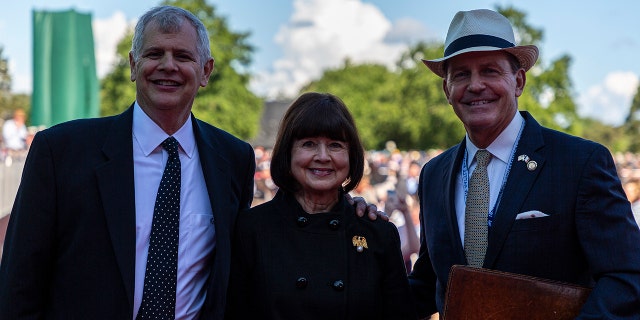
Robert Delassandro (far left) told Fox News Digital he feels privileged to be able to combine his passion for history with the knowledge gained from his 29 years of service in the Army.
(ABMC)
Dalessandro himself served for 29 years in the Army (1980-2009) between operational and “history assignments,” which included a stint as director of the U.S. Army’s Center for Military History. He rose to the rank of colonel.
“I never thought I’d do anything but go in the Army,” he said.
His love of history and his desire to preserve the memories of America’s war heroes were inspired by family trips to Gettysburg, Pennsylvania.
Even as a boy, he marveled at the battlefield strewn with memorials to the dead — some monumental in scope, others equally touching in their humble, reverent simplicity.
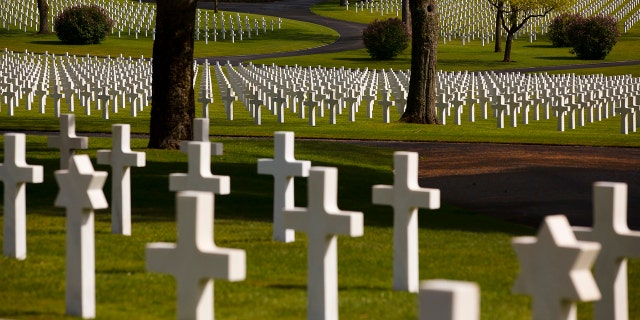
American Battle Monuments Commission cemeteries memorably feature the pristine white marble gravestones of some 125,000 Americans killed in wartime, all arrayed in perfect alignment.
(ABMC)
At ABMC, he said, “it is our job, every day of the year, to take care of those who gave the last full measure,” said Dalessandro, the last four words a poetic reference to the fallen from Lincoln’s Gettysburg Address.
Dalessandro attended the Virginia Military Institute before earning his Army commission. He holds three master’s degrees, in archeology, museum science and strategic studies, from William & Mary, George Washington University and the Army War College, respectively.
‘Near and dear to my heart’
Dalessandro has shared his research and passion throughout his 12 books.
His works range from the children’s book, “The Great War: A World War I Historical Collection,” to more academic and instructional tomes such as the “Army Officer’s Guide.”
“Taking care of our fallen — it’s an awesome responsibility.”
He has a specific interest in World War I and has authored several books on the conflict, including “Over There: America in the Great War” and “Willing Patriots: Men of Color in the First World War.”
He was invited to join the ABMC by its former secretary, Sen. Max Cleland (D-Ga.), an Army veteran who passed away last year.
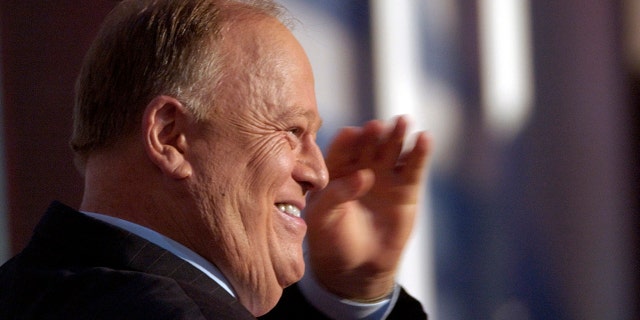
Former Sen. Max Cleland, D-Ga., is shown during the Democratic National Convention in July 2004 at the Fleet Center in Boston, Mass. Cleland, who lost three limbs to a Vietnam War hand grenade blast but went on to serve as a senator from Georgia, died on Nov. 9, 2021. He was 79.
(AP Photo/Ed Reinke, file)
“It is something near and dear to my heart,” Dalessandro said. “Taking care of our fallen — it’s an awesome responsibility.”
Most of the 200,000 Americans in his care — about 125,000 — lay beneath chillingly beautiful rows of pristine white marble crosses and Stars of David.
The stunning images of these meticulously maintained gravestones have been popularized in American iconography, including in the opening and closing scenes of the landmark World War II epic “Saving Private Ryan.”
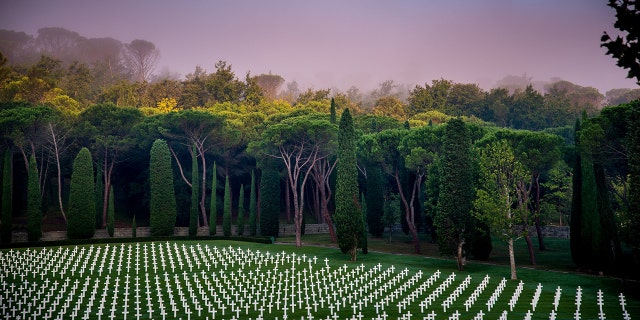
The ABMC manages 26 beautifully manicured cemeteries around the world, located in Belgium, France, Italy, Luxembourg, Mexico, Netherlands, Panama, Philippines, Tunisia and the United Kingdom — plus an additional 32 war monuments as far away as the Marianas Islands and New Zealand.
(ABMC)
These stark symbols of faith are the hallmark of ABMC cemeteries.
But another 76,000 American men and women, mostly from World Wars I and II, remain missing in action.
Their names are listed without graves on memorials at cemeteries near where they fought and disappeared.

Sgt. Paul McErlane of Lowell, Mass., died over Europe while serving on a bomber crew in World War II. He is remembered today at the Netherlands American Cemetery in a memorial to those missing in action. He’s one of thousands of Americans whose remains were never recovered and who are honored in MIA memorials at AMBC cemeteries.
(Kerry J. Byrne/Fox News Digital)
Where Americans rest in peace
The Normandy American Cemetery on a bluff overlooking Omaha Beach — the one featured so powerfully in “Saving Private Ryan” — is the most well-known and most visited ABMC cemetery.
But it’s one of only 25 monuments and cemeteries in France alone, and hardly the largest, among a global network of fields honoring America’s war dead.

Gravestones at the Normandy American Cemetery in France stand in perfect alignment on a bluff overlooking the Atlantic Ocean. Many of the Americans buried here were killed on Omaha Beach, directly below, during the D-Day invasion on June 6, 1944.
(Kerry J. Byrne/Fox News Digital)
Fewer than 1,600 Americans, mostly from World War I, rest at the small Suresnes American Cemetery.
It stands on a hill that offers sweeping views of Paris below and the Eiffel Tower in the distance.
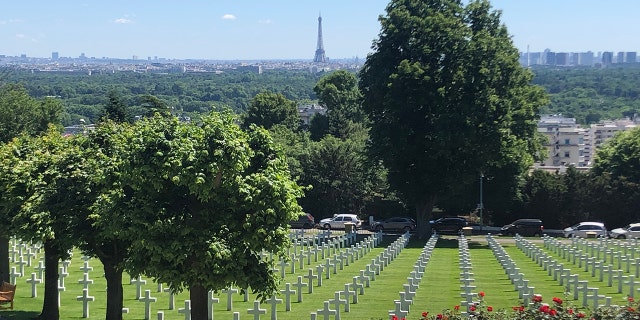
Nearly 1,600 soldiers killed in World War I have rested for almost a century at the Suresnes American Cemetery, stunningly situated on a hill overlooking Paris and the Eiffel Tower.
(Kerry J. Byrne/Fox News Digital)
The largest ABMC cemetery is in the Philippines, on a crest overlooking the skyline of Manila.
There rests 16,859 military dead who were killed in the Pacific in World War II. The cemetery also honors 36,286 individuals missing in action.
Dalessandro’s organization also cares for cemeteries in Belgium, Italy, Luxembourg, Mexico, Netherlands, Panama, Tunisia and the United Kingdom. Each is hauntingly beautiful.
American youth heroically rose from the Atlantic Ocean on June 6, 1944, D-Day, to liberate Europe.
Most cemeteries are accented by dignified chapels or monumental artwork. The bone-chilling Spirit of American Youth Rising from the Waves stands at the head of the rows of graves overlooking Omaha Beach, where American youth heroically rose from the Atlantic Ocean on June 6, 1944, D-Day, to liberate Europe.
Several famous Americans are buried in these cemeteries.
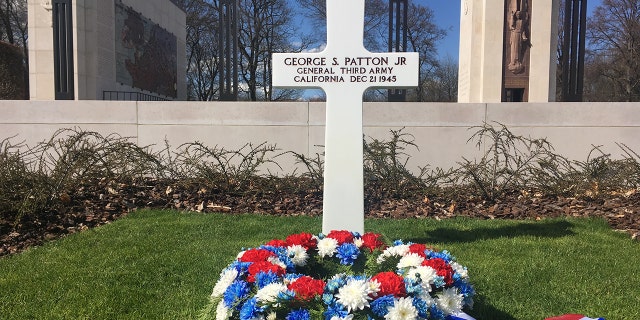
General George S. Patton’s grave at the Luxembourg American Cemetery outside Luxembourg City stands on a singular plot facing rows and rows of the gravestones of American soldiers.
(Kerry J. Byrne/Fox News Digital)
Gen. George S. Patton rests at the Luxembourg American Cemetery, where his singular grave is distinctively set apart, looking over row upon row of the dead, as if he’s still commanding soldiers in eternal battle today.
U.S. Army Sgt. Warren “Skip” Muck and PFC Alex Penkala rose to posthumous fame as two of the paratroopers celebrated in the landmark HBO World War II series “Band of Brothers.”
‘BAND OF BROTHERS’ VETERAN BILL WINGETT LAID TO REST IN OREGON
They were annihilated by a German shell in their foxhole during the Battle of the Bulge as they urged another man to safety. Their gruesome deaths marked the psychological nadir, “The Breaking Point,” in the real-life “Band of Brothers” saga.
Both are buried a short distance from Patton in Luxembourg.
Brothers Quentin and Theodore Roosevelt Jr., sons of President Teddy Roosevelt, lay side by side in Normandy. Quentin was a World War I pilot; he was shot down, killed and buried elsewhere in France.
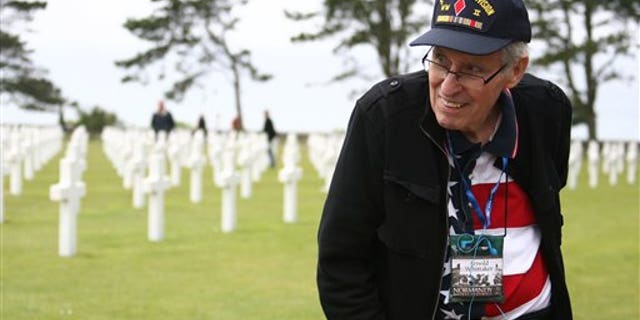
WWII veteran Arnold Whittaker of Atlanta — of the 3rd Army, 5th Infantry Division, 10th Infantry Regiment Company K — is shown visiting the U.S military cemetery in Colleville sur Mer, western France, on June 6, 2011.
(AP Photo/Vincent Michel)
More than 25 years later, Teddy Jr. helped lead the invasion of Utah Beach on D-Day, and was awarded the Medal of Honor for his heroism that day.
His contributions to the D-Day invasion were chronicled in both the 1959 book and the 1962 ensemble-cast Hollywood epic “The Longest Day.”
REMEMBERING D-DAY: ‘WE’RE HERE BECAUSE OF WHAT THEY DID’
Quentin Roosevelt’s body was moved next to his brother’s in Normandy at the request of former President Roosevelt. He is the only World War I soldier buried at the Normandy American Cemetery.
Mostly, the names on the graves are of ordinary Americans, those whom author Stephen Ambrose called “citizen soldiers.”
Also, it’s the only known site in the entire ABMC network where World War I and World War II service members are buried side by side, said the organization’s historian, Ben Brands.
Mostly, the names on the graves are of ordinary Americans, those whom author Stephen Ambrose called “citizen soldiers.” They rose to accomplish extraordinary deeds on the battlefield.
‘The glory of their deeds’
General John J. Pershing issued the American Battle Monuments Commission’s “glory of their deeds” motto.
He led the American Expeditionary Force “Over There” in World War I and was the commission’s first director.
COMBAT VETERAN AND HIS WIFE HELP OTHERS FIGHT PTSD — AND FIND HEALING AND HOPE
The ABMC was created in 1923, in the aftermath of the slaughter of World War I, in which 117,000 Americans were killed in just a few short months of combat.
Families whose loved ones were killed in combat were given the option of having the body repatriated to the United States, or having “the remains interred, overseas, at an American military cemetery, where they [would] be cared for, in perpetuity, by the United States government,” said Brands.
“Every day, we make sure that those cemeteries are perfectly maintained, perfectly operated and ready at any moment for visitation by anyone.”
To the surprise of many, 40% of American families chose to have their sons and daughters buried in Europe.
Families were given the same sad choice in World War II, leading to a dramatic expansion of the size and global scope of the ABMC mission.

The American Battlefield Monuments Commission “honors those who rest” throughout its network of cemeteries, said Robert Dalessandro. “It is a tremendous responsibility,” he said.
(ABMC)
Along the way, battlefield cemeteries such as one in Mexico City, where 1,500 soldiers killed in the Mexican-American War are buried, were taken under the ABMC umbrella and given a renewed sense of dignity.
The American dead at the Mexico City National Cemetery include 750 unidentified soldiers, “known but to God,” as a marker above their common burial site reads.
MEET THE AMERICAN WHO INVENTED LIGHT BEER
Gravestones throughout the network contain the remains of men and women who were never identified.
“Every day, we make sure that those cemeteries are perfectly maintained, perfectly operated and ready at any moment for visitation by anyone,” Dalessandro said.
“And we do that to honor those who rest there. It is a tremendous responsibility.”
CLICK HERE TO GET THE FOX NEWS APP
Pershing’s promise that “time shall not dim the glory of their deeds” has, Dalessandro said, “gone unbroken for 100 years.”
